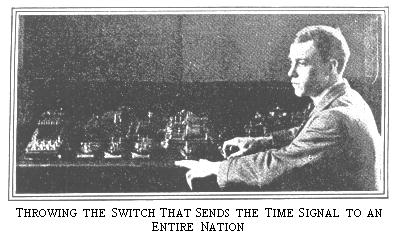Ath the time this article appeared, NAA, the Navy's station in Arlington, Virginia, broadcast daily time signals in Morse code, using a rotary-gap spark transmitter. This service was one of the first broadcast uses of radio, and was particularly popular with jewelers, which resulted in a niche market for early radio receiver manufacturers. By the early 1920s NAA had switched to audio transmissions, and moved its operations to a standard broadcasting frequency, 690 kilohertz on the AM (mediumwave) band.
Wayne Schlitt's "Elgin Watch Collectors Site" includes an online scan of a company booklet issued circa 1915, Receiving Time by Wireless, which includes detailed instructions for picking up the NAA time signals.
Technical World Magazine, October, 1913, pages 232-233:
R E G U L A T I N G 1 0 , 0 0 0 C L O C K S B Y W I R E L E S S
B y
A L F R E D H . O R M E

AT the instant of noon in Washington, the wireless station at Arlington, just across the Potomac, which is the most powerful in the world, hammers from its towers a time signal that goes off into the void, to be picked up at Chicago, Galveston, San Francisco, and many other points. The flash of it regulates many a jeweler's clock, bringing the hands into an instant adjustment of correct time. For an old sidereal timepiece, about which is built a great scientific institution, is back of that flash, and the time of its sending is determined by the reading of the stars, the only absolutely accurate way of telling the time of day.
Formerly the noontime signal sent out from the Naval Observatory at Washington was distributed only over the commercial telegraph lines, but on the petition of jewelers throughout the country the Navy Department consented to give for this purpose the use of the mammoth Arlington station.
According to officials of the Naval Observatory, an apparatus, suitable for receiving the wireless time signal sent out from Arlington, can be purchased for less than one hundred dollars, whereas the regular annual rate paid under the old arrangement by jewelers and other persons to whom the correct measurement of time is of vital importance, averaged about eighty dollars per year. The advantages of the new method over the old are so obvious that it is estimated that ten thousand clocks in all parts of the country will soon be regulated by wireless.
The wireless service is most desirable from the standpoint of accuracy. It is acknowledged even by enemies of the new system that it is far ahead of the old in this respect. According to scientists at the Naval Observatory who have conducted an exhaustive series of experiments along this line, only one-twentieth of a second is lost in transmission between the Arlington station and San Francisco via wireless. It was on the ground that the time signal was subject to many delays during transmission over the regular commercial telegraph wires that the plea of the American jewelers for a wireless service was based. A system of national scope is the result.

From the great sidereal clock in the Naval Observatory--a veritable "father time"--the time signal is originally derived, and this clock is regulated, in turn, by means of an electrical device operated automatically from a similar timepiece installed in the vault of the Astronomical Observatory. Each night the government astronomers study the stars, which are the final and ultimate source of all terrestrial time, and from their observations they are able to regulate exactly the primary sidereal clock in the vault which automatically passes on the correct time to the second clock installed in the sending room of the observatory. Two other clocks, less imposing but almost as accurate as the sidereal chronometers, fitted with electrical contact points on the hands, receive the time from the second sidereal clock, and actually place the signal on the wires when the switch is thrown at five minutes to noon and five minutes to ten o'clock at night. So short is the distance between Arlington and the Naval Observatory that the signal is sent this far on its journey over an ordinary telegraph wire and is then relayed through the great "sending" apparatus of the wireless station to every corner of the United States.
Each day at five minutes before the designated signal hours, the electric switch is thrown and the "contact" clocks are placed in action. These chronometers in tolling off the seconds complete the circuit with every swing of the pendulum and send a spark along the wire to Arlington where it is literally shoved off into space through the antennæ of the wireless masts. Thus does it become possible for the liner in the middle Atlantic or the farmer's boy in Kansas who has an experimental apparatus, to catch the tick of the official time clock at Washington. In the preliminary signaling every second is marked by a "dot" except the twenty-ninth, fifty-sixth, fifty-seventh, fifty-eighth, and fifty-ninth which are left blank in each of the five minutes. After the divisions of the five minutes before the hour, comes the flash of the exact hour.



